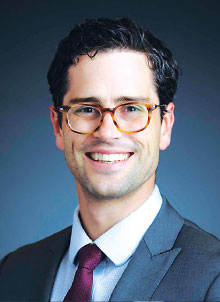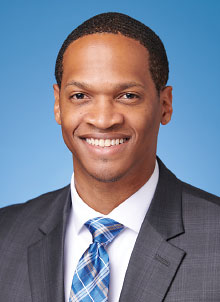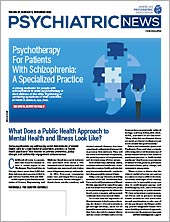The mean out-of-pocket cost of naloxone jumped 506% between 2014 and 2018 for people who don’t have health insurance, even as the mean out-of-pocket cost decreased 26% for those who do have insurance, a study in JAMA Health Forum has found. However, much of the increase in cost for people without insurance is tied to a jump in the price of Evzio, an auto-injector that delivers naloxone.
The findings represent a glaring disparity in health equity and run counter to broad state and national efforts to increase access to the life-saving overdose antidote, the study’s lead author Evan D. Peet, Ph.D., told Psychiatric News.
“While laws like standing orders and prescribing authority [for pharmacists] theoretically increase the ability for anyone to obtain naloxone and prevent an overdose death, those laws do not address the practical concern of costs,” said Peet, a health economist at the RAND Corporation and a professor at the Pardee RAND Graduate School. “For some, particularly uninsured patients, the out-of-pocket costs required mean they have been unable to obtain naloxone from a retail pharmacy. The disparity between the out-of-pocket costs for naloxone borne by the insured and uninsured are a microcosm of the disparities in access that we see throughout our health care system.”
Peet and colleagues analyzed naloxone claims data from Symphony Health to determine the mean out-of-pocket costs for people who filled naloxone prescriptions between January 2010 and December 2018, according to drug brand and payer. (Symphony Health compiles prescription claims data from retail pharmacies.) Overall, there were 719,612 claims, including 172,894 for generic naloxone, 501,568 for Narcan, and 45,150 for Evzio.
For insured people, between 2014 and 2018 the mean out-of-pocket cost for generic naloxone rose from $7.36 to $9.36, and the mean out-of-pocket cost of Evzio decreased from $35.62 to $27.23. Narcan did not enter the market until 2016, when people with insurance paid a mean of $14.18 out of pocket for it, which decreased to $13.19 in 2018.
For uninsured people, between 2014 and 2018 the mean out-of-pocket cost for generic naloxone decreased from $73.89 to $18.44, and the mean out-of-pocket cost of Evzio skyrocketed from $51.75 to $1,591. The mean out-of-pocket cost for Narcan decreased for this population from $87.95 in 2016 to $60.70 in 2018.
“If a patient showed up at a pharmacy in need of naloxone but that pharmacy only carried Evzio, they would end up having to pay between 14.8 and 16 times as much for naloxone than if the pharmacy offered Narcan or generic naloxone,” Peet explained. “The disparity in access to naloxone caused by cost barriers stood out to us because uninsured patients are a vulnerable and critical population representing approximately 20% of adults with an opioid use disorder and about 30% of adults that end up dying as a result of opioid overdoses.”
Walter E. Wilson Jr., M.D., M.H.A., chair of APA’s Council on Minority Mental Health and Health Disparities, said the out-of-pocket costs for uninsured people act as a barrier to access.
“Evzio being so expensive puts it out of reach of probably 99% of people who are uninsured. Even the $60 [for Narcan] is a pretty big deterrent for patients who are uninsured,” said Wilson, who is a child and adolescent psychiatrist at HealthPoint Family Care in Covington, Ky., and was not involved in the research.
Wilson added that the out-of-pocket costs particularly affect patients who identify as Black, Indigenous, and People of Color (BIPOC), and Black patients in particular, citing research about the higher rates of overdose deaths in this population. For example, a study in the July 22 Morbidity and Mortality Weekly Report (MMWR) found that although overdose deaths increased 30% in the United States from 2019 to 2020, overdose death rates increased by 44% and 39% among non-Hispanic Black and non-Hispanic American Indian or Alaska Native people, respectively. People who identify as lesbian, gay, transgender, or queer/questioning (LGBTQ) are also at increased risk: The 2020 National Survey on Drug Use and Health (NSDUH) found that 1.1 million people in this population have misused opioids such as prescription hydrocodone, oxycodone, or fentanyl or have used heroin in the past year.
“These populations are particularly vulnerable, and we have to make sure that they’re targeted for naloxone access in an affordable way,” Wilson said.
Fortunately, there are alternatives to pharmacies for obtaining naloxone. Many states and nonprofit organizations have community or statewide programs that provide free Narcan or naloxone either with no requirements or with minimal requirements such as watching a video and taking a short test on how to administer the drug. Indeed, Peet and colleagues cited Food and Drug Administration data suggesting that 83% of naloxone products were sold to nonretail settings in 2017.
“If that 83% is targeting groups that have disproportionate risk, that may be an answer for addressing the disparities,” Wilson said. “Populations who use nontraditional ways of getting things tend to be uninsured and coincide with groups that have low socioeconomic status. There are programs that attempt to get medications to these populations at little to no cost. I would think and pray that’s how our uninsured population could get naloxone, through a grassroots approach.”
The study in JAMA Health Forum was supported by the Centers for Disease Control and Prevention. The authors of the MMWR study reported no outside funding. The NSDUH is conducted annually by the Substance Abuse and Mental Health Services Administration. ■


